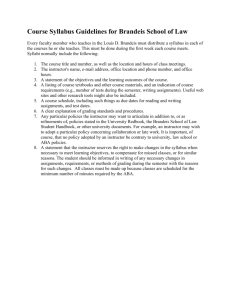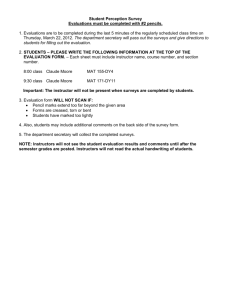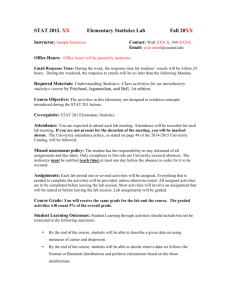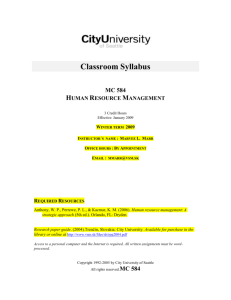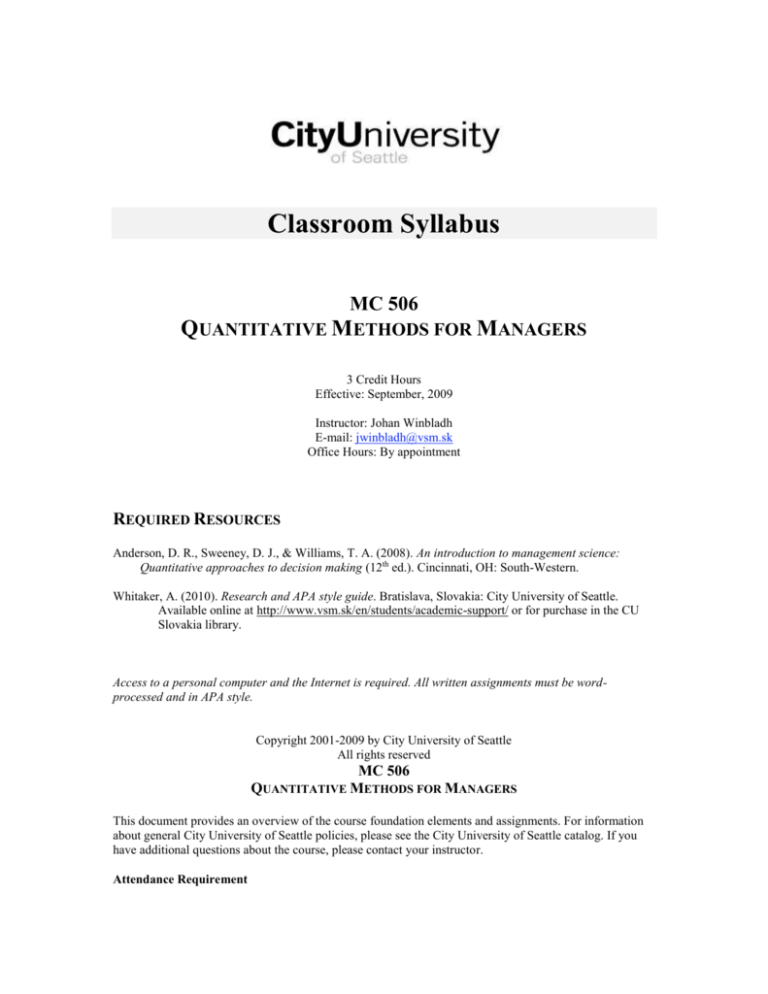
Classroom Syllabus
MC 506
QUANTITATIVE METHODS FOR MANAGERS
3 Credit Hours
Effective: September, 2009
Instructor: Johan Winbladh
E-mail: jwinbladh@vsm.sk
Office Hours: By appointment
REQUIRED RESOURCES
Anderson, D. R., Sweeney, D. J., & Williams, T. A. (2008). An introduction to management science:
Quantitative approaches to decision making (12th ed.). Cincinnati, OH: South-Western.
Whitaker, A. (2010). Research and APA style guide. Bratislava, Slovakia: City University of Seattle.
Available online at http://www.vsm.sk/en/students/academic-support/ or for purchase in the CU
Slovakia library.
Access to a personal computer and the Internet is required. All written assignments must be wordprocessed and in APA style.
Copyright 2001-2009 by City University of Seattle
All rights reserved
MC 506
QUANTITATIVE METHODS FOR MANAGERS
This document provides an overview of the course foundation elements and assignments. For information
about general City University of Seattle policies, please see the City University of Seattle catalog. If you
have additional questions about the course, please contact your instructor.
Attendance Requirement
Students must take part in all class activities. Failure to report for 25% of the classes (class hours) will
result in being dropped from the class. (Loss of eventual complete Financial Aid will result.)
Late Assignments Policy
No late papers will be accepted.
Notification to Students with Disabilities
If you are a student with a disability and you require certain help, please contact the program manager or
your instructor as soon as possible.
SCHOLASTIC HONESTY POLICY
City University of Seattle expects each student to do his/her own work. The University has "zero
tolerance" for cheating, plagiarism, unauthorized collaboration on assignments and papers, using "notes"
during exams, submitting someone else's work as one's own, submitting work previously submitted for
another course, or facilitating acts of academic dishonesty by others. Scholastic Honesty policy applies
also to online discussions that represent a part of assignments in online courses. You should cite all the
information. Every reference material used in discussion contributions must be cited according to the
current Research & APA Style Guide. The penalties are severe! A first offense results in a zero grade for
the course and suspension for one quarter; a second offense can result in a zero grade for the course and
suspension for two or more quarters; a third offense can result in expulsion from the University. The
Policy and Procedures may be found http://www.vsm.sk/en/students/scholastic-honesty/policies-andprocedures/ .
In addition to providing your work to the instructor for grading, you must also submit an electronic copy
for the City University of Seattle archives (unless the work is specifically exempted by the instructor). You
will not receive a grade for particular work until and unless you submit this electronic copy. The procedure
for submitting work to the archives is to upload it via the website http://www.vsm.sk/en/students/on-linecenter/uploader/uploader.html . Files should include the cover page of the work with the student name,
instructor name, course name and number, and date. File names should indicate the type of assignment,
such as “researchpaper.doc”, “casestudy.doc” or “ thesis.doc” (student name should not be a part of the file
name because the system adds it). All files received into the archives are submitted to www.TurnItIn.com
for plagiarism checking.
COURSE DESCRIPTION
In order to be effective in today’s increasingly complex and computerized business environment, managers
need to use a variety of mathematical and scientific tools for analysis, planning, monitoring, and decision
making. This course covers important quantitative management techniques, including basic statistics, linear
programming, regression analysis, project and inventory modeling, and decision making and forecasting
methodology. By learning the concepts and how to apply the tools to practical business situations, students
will acquire a necessary foundation for most of the other courses in their MBA programs, as well as for
their future business careers.
LEARNING GOALS
Upon the successful completion of this course, you will be able to:
1. Compare and contrast the quantitative and qualitative approaches to management decision making;
2. Solve linear programming problems to identify optimal solutions;
3. Analyze quantitative case problems and prepare managerial recommendations;
4. Develop network representations;
5. Develop activity schedules for project networks;
MC 506
SYL
Page 2
Eff: 09/2009
6. Synthesize data as part of problem sets;
7. Prepare recommendations for simulations;
8. Evaluate how decision analysis is used to identify the best decision alternative;
9. Develop forecasts using both quantitative and qualitative methods;
10. Solve linear programming problems with the use of a computer software program.
CORE CONCEPTS
To achieve the goals of this course, you will need to master the following core concepts:
1. Quantitative analysis and decision making;
2. Linear programming problems for maximization and minimization problems;
3. Models of cost, revenue, and profit;
4. Breakeven analysis;
5. Graph linear equations;
6. Interpret computer output and solutions;
7. Sensitivity analysis;
8. Network models: Transportation, Assignment, Transshipment, and Production and Inventory;
9. Project scheduling with PERT/CPM;
10. Inventory models: Economic Order Quantity (EOQ), Economic Production Lot-Size, Single-Period,
Quantity Discounts for the EOQ, Order-Quantity, Reorder-Point, Periodic-Review, and Just-in-Time;
11. Simulations;
12. Decision analysis in the face of uncertainty or risk;
13. Smoothing methods, trend projection, trend and seasonal components, and regression analysis in
forecasting;
14. Qualitative approaches to forecasting: Delphi method, Expert judgement, Scenario Writing, and
Intuitive approaches.
RECOMMENDED SUPPLEMENTARY RESOURCES
The CU Slovakia library home page is at http://library.cutn.sk/. For additional help, visit the Slovakia
library or submit your question in the Contact Us section of the Slovakia library’s web site.
As a City University of Seattle student, you have access to library resources regardless of where and
how you are taking this class. To access the resources that are necessary to complete your coursework and
assignments, visit the library menu in the My.CityU portal at http://my.cityu.edu.
A good place to begin your research is through the program or course resource sections that provide links
to relevant journals, books, and Web sites. Search the library's online catalog to locate books and videos,
and place requests to have items mailed to you (services vary by location). Search the online databases for
journal, magazine, and newspaper articles. Articles that are not available full text in the library's collection
can be requested from other libraries and delivered to you electronically.
MC 506
SYL
Page 3
Eff: 09/2009
For additional help, submit your question via the Ask a Librarian e-mail service available through
the portal or call 800.526.4269 (U.S. or Canada) or 425.709.3444.
OVERVIEW OF COURSE ACTIVITIES AND GRADING
The grade you receive for the course will be derived using City University of Seattle’s decimal grading
system, based on the following:
Assignments
Case Problems (two @ 25%)
50%
Final Examination
50%
Practice Problems
0%
TOTAL
100%
Please see the current City University of Seattle catalog or consult your instructor for guidance in
determining your decimal grade.
EXPLANATION OF ASSIGNMENTS AND GRADING
CASE PROBLEMS
The two case problems are described below. For each case, you are to choose one of the alternatives listed.
(Your instructor will assign the cases in class.) The list of cases can be changed.
The case problems should use the required computer software or other appropriate software approved by
the instructor. For each case problem, you are required to develop a managerial report which consists of an
appropriate combination of several of the following elements (as specified in the text): graphical
representation of data, establishment of a decision tree, development of a model, development of a
computer program, evaluation of alternative systems, synthesis of data, summary of findings, and the
preparation of recommendations. Your instructor will provide the specific format and guidelines for your
case problems.
Case Problem #1
One of the three case problems described in Chapter 2 or chapter 10 of your textbook.
Case Problem #2
One of the case problems described in either Chapter 11, 14 or 16 of your textbook.
Grading Criteria for Case Problems
Clear demonstration of ability to employ concepts, methods, and
techniques
Logical and sequential development of results and recommendations
20%
Appropriate depth of analysis
20%
Appropriate organization and format
10%
Successful problem completion
10%
Grammar, spelling, and syntax
20%
TOTAL
100%
MC 506
SYL
Page 4
Eff: 09/2009
20%
FINAL EXAMINATION
You should be prepared to answer a variety of types of questions pertinent to the concepts
covered or suggested by the course materials, assignments, and activities. Your instructor may
provide you with additional information about the content, style, and grading criteria of exams in
this course.
Grading Criteria for Essay Questions on Examination
Clear grasp of major issues posed by the question
Valid arguments; appropriate supportive detail
Appropriate analysis, evaluation, and synthesis
Demonstrated ability to employ terms, concepts, and frames of reference
from texts, lectures, and other course materials
Proper organization and logical flow of responses
TOTAL
20%
20%
20%
20%
20%
100%
PRACTICE PROBLEMS
Your instructor will assign practice problems to help enhance your learning of the course material. The
problems are not graded but are to be used for your own feedback and study.
PROFESSIONAL PRESENTATION OF WRITTEN WORK
All assignments submitted for this course should be of professional quality. The student should present
each paper in a format that would be appropriate for submitting to upper management.
This course requires that you use the American Psychological Association (APA) style in preparing any
written work where other sources are used. A recommended style guide is included in the Required
Resources section. Refer to this style guide for proper format, referencing methods, and bibliographic
format. References should be cited for all facts, ideas, conclusions, and opinions not your own.
A proper title page should preface all written assignments, unless otherwise required. The title page should
include: your name, the title of the paper, the name and number of the course, the date submitted, and the
name of the instructor.
Your instructor may prefer you to submit your written assignments electronically. Hard copies of your
work should be typed or word-processed on white A4 paper and double spaced. Some assignments may
require that your work be prepared on a computer spreadsheet.
When submitting hard copies, do not use binders or special covers. Staple your completed assignments in
the upper-left hand corner. Your instructor may have different or additional requirements for the
submission of written work.
RECOMMENDED COURSE SCHEDULE
The schedule for course activities and assignments is below. If you find you are unable to complete the
assignments as scheduled, contact your instructor. Your instructor may elect to adjust the outline to meet
the unique needs of the class.
MC 506
SYL
Page 5
Eff: 09/2009
Note: The specific weekly end of chapter practice problems will be determined by the instructor. These
problems are not graded and solutions to some are located in the solutions manual in the book.
SESSION TOPICS AND ASSIGNMENTS
READINGS
1
Introduction
An Introduction to Linear Programming
Linear Programming: Sensitivity Analysis and
Interpretation of Solution
Practice Problems;
1.4, 1.8, 1.10, 1.12, 2.1, 2.3, 2.6, 2. 10, 2.22, 3.3
Chapters 1.1-1.5
and 2.1-2.5
Chapter 3.1-3.3
2
Distribution and Network Models
Project Scheduling: PERT/CPM
Practice Problems;
9.1, 9.6, 9.15, 10.3, 10.4, 10.6
Chapter 9.1-9.3
Chapter 10.1-10.3
3
Inventory Models
Practice Problems;
11.1, 11.2, 11.4, 11.13
Chapter 11.1-11.4
4
Waiting Line Models
DUE: Case Problem #1
Practice Problems;
12.2, 12.4, 12.5, 12.12, 12.18
Chapters 12.1-12.3
5
Simulation
Practice Problems;
13.2, 13.5, 13.6, 13.10
Chapter 13.1-13.3
6
Decision Analysis
Forecasting
DUE: Case Problem #2
Practice Problems;
14.2, 14.3, 14.7, 16.1, 16.4, 16.14, 16.25, 16.34
Chapter 14.1-14.3
Chapter 16.1-16.5
7
DUE: Final Examination
MC 506
SYL
Page 6
Eff: 09/2009




